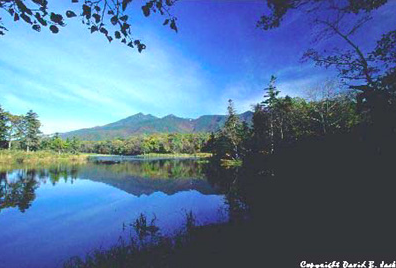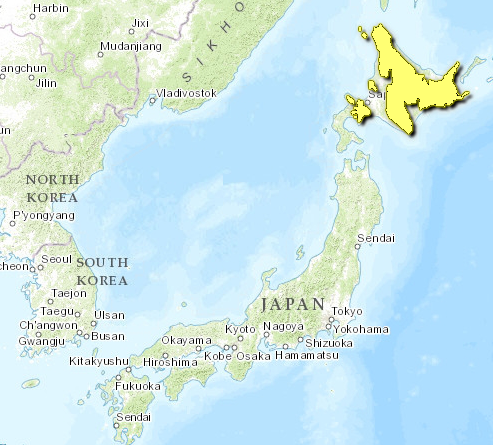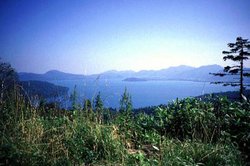Hokkaido montane conifer forests
Introduction This mountainous (Hokkaido montane conifer forests) ecoregion is located on the island of Hokkaido, the northern most island of Japan. Daisetsuzan National Park, Japan’s largest national park, is located in the center of this region. A subarctic and subalpine climate containing spruce and fir provides habitat for species not found elsewhere in Japan.
Location and General Description
The island of Hokkaido is the northernmost in the Japanese archipelago. The island faces the Sea of Okhotsk and is separated from Honshu by the Tsugaru Strait and from Sakhalin by the Soya Strait. While the lowlands of Hokkaido represent a transitional zone between cool temperate forests to the south and subarctic forests to the north, this mostly upland ecoregion is situated in the cold-temperate and subarctic/subalpine climate zones. The island faces the Sea of Okhotsk and is separated from Honshu by the Tsugaru Strait and from Sakhalin by the Soya Strait. This ecoregion consists mainly of central highland area, Daisetsu mountain range, which is largely volcanic, and the eastern hills and lowlands under the strong influence of the cold Chishima Current, where the conifer line goes down to the sea level. Hokkaido has an average temperature of eight degrees centigrade and receives an average annual precipitation of 1,150 millimeters (mm). The Tokachi river is the major river system of this ecoregion.
Daisetsuzan National Park, found within this ecoregion, is the largest national park in Japan. The Daisetsu mountain range, also called the "The Roof of Hokkaido", has the highest mountain on Hokkaido (Asahidake), which is approximately 2290 meters (m) in elevation.
The dominant forest cover is Asian spruce Picea jezoensis and Sachalin fir Abies sachalinensis and P. glehnii, with P. glenhnii sometimes found in pure stands in swamps, rocky slopes, gravelly volcanic soils. The coniferous species are sometimes accompanied by birch species (Betula ermanii and B. maximowicziana), which themselves form pure stands at upper tree line and in areas recovering from fires.
Conifer forests are found up to an elevation of approximately 1,500 m in Hokkaido – above this point alpine conditions predominate. Stone pine (Pinus pumila) forms dense, low (1-2 m) thicket communities in alpine areas, with a poorly developed understory but vigorous mosses on the ground. Deciduous broad-leaved scrub communities are also found in the alpine zone – the main associations found in Hokkaido are a birch-alder (Betula ermanii-Alnus Maximowiczii) and mountain ash (Sorbus sambucifolia). Alpine heaths composed conspicuously of Empetrum nigrum and dwarf shrubs (Arcterica nana-Loiseleuria procumbens association) form at some of the highest altitudes.
Biodiversity Features
The central mountain ranges in this ecoregion harbor many rare and endemic flora particularly in areas with serpentine rocks. For example, Salix paludicola, chickweed Stellaria pterosperma, Aconite Aconitum yamazakii, and Draba nakaiana are endemic to Mt. Daisetsu. The flora of Mt. Apoi contains by far the greatest number of endemics within Hokkaido and one of the most distinct among the serpentine communities of Japan. Some of the remarkable serpentine relics there are Hypochoeris crepidioides, Callianthemum miyabeanum, Crepis gymnopus, Rhamnus ishidae, Betula apoiensis, Viola hidakana, and Primula hidakana.
Hokkaido contains over 230 species of birds, including those associated with northern latitudes that are not seen in the rest of Japan, including Vulnerable Stellar’s sea eagle (Haliaeetus pelagicus), white-tailed sea eagle (Haliaeetus albicilla), common merganser (Mergus merganser), tufted puffin (Lunda cirrhata), hazel grouse (Tetrastes bonasia), three-toed woodpecker (Picoides tridactylus), and willow tit (Parus palustris). An endemic sub-species of hazel grouse (Tetraste bonasia vicinitas) is also found in the ecoregion.
There are approximately 44 species of mammals in the ecoregion. These are mostly small mammals such as microbats, rodents, rabbits, and small mustelids. Red foxes (Vulpes vulpes) are present. There is an Endemic subspecies of the more widespread Sika deer (Cervus nippon yesoensis) which the IUCN considers Data Deficient.
The fauna in this ecoregion includes Japan's largest mammal species: the Yezo brown bear (Ursos arctos yesoensis). Hokkaido is the only portion of Japan which supports a population of brown bears. The Yezo brown bear is considered a subspecies and is also found on the neighboring Russian controlled islands. The brown bear is an area-sensitive focal species for conservation planning in the ecoregion. There are five subpopulations on the island.
There is also an endemic sub-species of pika (Ochotona hyperborea yesoensis) and sable (Martes zibellina brachyura). The pika is a remnant of the glacial age in and has very narrow habitat range in the central [[mountain]s] around Mt. Daisetsu. The Japanese sable is threatened by breeding with the Japanese marten (Martes melampus), which was introduced to Hokkaido.
Blakiston's fish owl (Keputa blakistoni) is a rare, Endangered bird found in this ecoregion. With a very limited range, it range is believed to be from the Hidaka mountain range to Nemuro and the Shiretoko Peninsula. This species is listed as a natural monument though no habitat has been specifically designated for it. Approximately 120 individuals are found in Hokkaido, though perhaps 1,500 birds combined are found in Russia and China.
The Endangered red-crowned, or Japanese crane (Grus japonensis) is considered a Natural National Monument - a symbol for happiness and longevity. The Hokkaido red-crowned cranes are resident year-round on the lowland east coast of the island while the mainland populations of red-crowned cranes are migratory.
Current Status
The subalpine coniferous forests that used to have even extended to the northeast hills and plains in coastal areas, for the most part, have been cut down. However, there still remain relatively intact large tracts of forests compared to the rest of the country. Mt. Daisetsu National Park is the largest national park in Japan covering several volcanic [[mountain]s] with extensive spruce and fir forests on its slopes.
Types and Severity of Threats
Unfortunately, the protection of the wildlife and plants from poaching, construction of roads, and tourism has not been very effective. Despite its protected status, sable population is declining due to poaching for its fur and the habitat loss.
Habitat loss and degradation, in the form of continued agricultural and industrial development constitute the principal threats to red-crowned cranes in Hokkaido. However, two active habitat management measures have allowed the Japanese red-crowned crane population to increase: winter feeding stations and the installation of conspicuous markers on utility lines. This latter action has reduced the rate of mortality from collisions approximately 60%.
On Hokkaido Blakiston’s fish-owl is threatened by traffic collisions, powerlines, and drowning in fish-farm nets.
Brown bears on the island are impacted by hunting for sport and damage control as well as vehicular collisions, but the greatest threat is the conversion of hardwood habitats into conifer plantations. The bears’ distribution has been contracting and there is evidence that annual harvests exceed sustainable levels. Efforts directed at public education regarding human-bear interactions and the need to conserve and plan around bear habitat have been identified as priorities.
Justification of Ecoregion Delineation
Ecoregion boundaries were derived from the ‘Vaccinio-Pinion’ and ‘Pinion jezoensis’ regions in Hokkaido. The southern boundary corresponds to the line between Hokkaido and the Japan Sea floral districts. This area captures temperate montane and subarctic coniferous forests to the north of the Kuromatsunai line. Abies sachalinensis, Picea jezoensis, and Picea Glehnii are the dominant conifer spp.
Additional information on this ecoregion
- For a shorter summary of this entry, see the WWF WildWorld profile of this ecoregion.
- To see the species that live in this ecoregion, including images and threat levels, see the WWF Wildfinder description of this ecoregion.
- World Wildlife Fund Homepage
Futher Reading
- Birdlife International. 2000. Threatened birds of the world. Lynx Edicions, Barcelona & Cambridge, UK. ISBN: 0946888396
- Brazil, M. 1991. The birds of Japan. Smithsonian Institution Press, Washington DC. ISBN: 0713680067
- Brooks, R.R. 1987. Serpentine and its vegetation: a multidisciplinary approach. Dioscorides Press, Portland, Oregon.
- Environment Agency of Japan. 1992. Nature Conservation in Japan: the 3rd Edition. Nature Conservation Bureau, Environment Agency of Japan, Tokyo, Japan.
- Higuchi, H., J. Minton, and C. Katsura. 1995. Distribution and ecology of birds of Japan, in Pacific Science 49(1):69-86.
- Higuchi, H., H. Morioka, and S. Yamagishi, editors. 1997. Encyclopedia of animals in Japan Volume 4: Birds II. Heibonsha Limited Publishers, Tokyo, Japan.
- Hilton-Taylor, C. compiler. 2000. The 2000 IUCN red list of threatened species. IUCN, Gland, Switzerland & Cambridge, UK. ISBN: 2831705657
- Ishizuka, K. 1974. Mountain vegetation. Pages 173-210 in M. Numata, editor. 1974. The flora and vegetation of Japan. Kodansha, Tokyo, Japan. ISBN: 0444998802
- Ishizuka, K. 1975. Mixed subarctic and cool temperate forests. Pages 63-71 in K. Numata, K.Yoshida, and M. Kato, editors, Studies in conservation of natural terrestrial ecosystems in Japan: Part I Vegetation and its Conservation. JIBP Synthesis volume 8. University of Tokyo, Press Tokyo, Japan. ISBN: 0860082180
- Ito, K. 1975. Mixed subarctic and cool temperate forests. Pages 53-58 in K. Numata, K.Yoshida, and M. Kato, editors. Studies in conservation of natural terrestrial ecosystems in Japan: Part I Vegetation and its Conservation. JIBP Synthesis volume 8. University of Tokyo, Press Tokyo, Japan. ISBN: 0860082180
- Izawa, K., T. Kasuya, and T. Kawamichi. 1996. Encyclopedia of animals in Japan Volume 2: Mammals II. Heibonsha Limited Publishers, Tokyo, Japan.
- Kamamichi, T. editor. 1996. Encyclopedia of animals in Japan Volume 1: Mammals I. Heibonsha Limited Publishers, Tokyo, Japan.
- Maekawa, F. 1974. Origin and characteristics of Japan’s flora. Pages 33-85 in M. Numata editor. The flora and vegetation of Japan. Kodansha, Tokyo, Japan. ISBN: 0444998802
- Miyawaki, A. 1975. Outline of Japanese vegetation. Pages 19-27 in K. Numata, K. Yoshida, and M. Kato, editors. Studies in conservation of natural terrestrial ecosystems in Japan. JIBPSynthesis volume 8. University of Tokyo Press, Tokyo, Japan. ISBN: 0860082180
- Ota, K. 1975. Studies of the animal communities in the terrestrial ecosystems and problems on their conservation: Mt. Daisetsu Area. Pages 5-10 in K. Numata, K. Yoshida, and M. Kato, editors. Studies in conservation of natural terrestrial ecosystems in Japan: Part II Animal Communities. JIBP Synthesis volume 9. University of Tokyo Press, Tokyo, Japan. ISBN: 0860082180
- Servheen, C., S. Herrero, B., Peyton, (compilers). 1999. Bears, Status Survey and Conservation Action Plan. IUCN/SSC Bear and Polar Bear Specialist Groups. IUCN, Gland, Switzerland & Cambridge, UK. ISBN: 2831704626
- Shidei, T. 1974. Forest vegetation zones. Pages 87-124 in M. Numata, editor. The flora and vegetation of Japan. Kodansha, Tokyo, Japan. ISBN: 0444998802
- Shimizu, T. 1975. Flora of Japan. Pages 16-18 in K. Numata, K. Yoshida, and M. Kato, editors. Studies in conservation of natural terrestrial ecosystems in Japan: Part I Vegetation and its Conservation. JIBP Synthesis volume 8. University of Tokyo Press, Tokyo, Japan. ISBN: 0860082180
- Swengel, S.R. 1996. Red-crowned crane, in Meine, C.D. and G.W. Archibald, editors. 1996. The cranes: - Status survey and conservation action plan. IUCN, Gland, Switzerland, and Cambridge, U.K. 294pp. ISBN: 2831703263
| Disclaimer: This article is taken wholly from, or contains information that was originally published by, the World Wildlife Fund. Topic editors and authors for the Encyclopedia of Earth may have edited its content or added new information. The use of information from the World Wildlife Fund should not be construed as support for or endorsement by that organization for any new information added by EoE personnel, or for any editing of the original content. |


